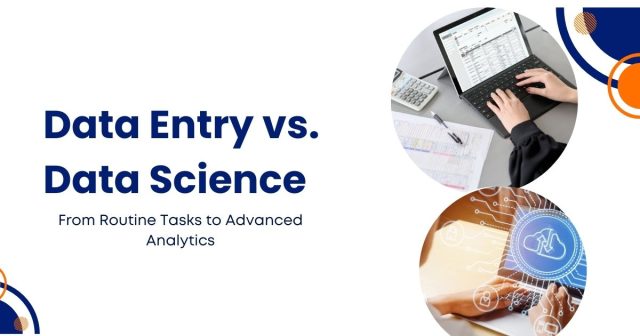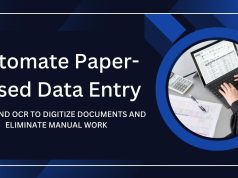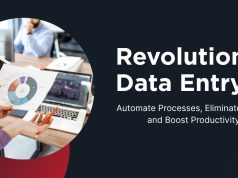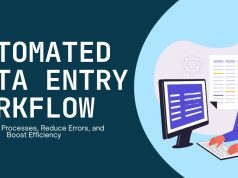As both work with data, data entry and data science may seem similar, but they are quite different in terms of their scope, skills, and purposes. You’re at the right place if you have been wondering whether data entry is data science, or you’re curious to know if you can get over to one of those from the other.
We’ll discuss the similarities and differences between data entry and data science, including the areas of overlap, and provide actionable advice to those looking to branch out into a data science career.
What Are Data Entry and Data Science?
Before we dig into comparisons, let’s define these two fields.
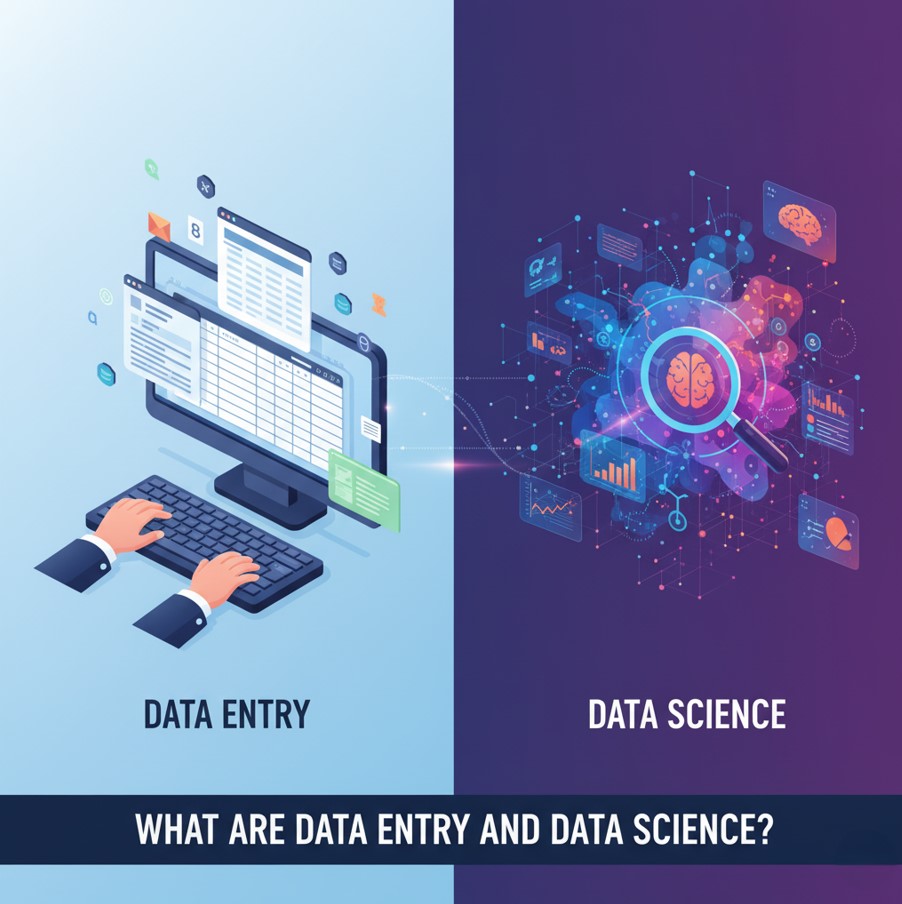
What Is Data Entry?
Data entry involves entering, updating, and maintaining data in various systems, such as spreadsheets, databases, or content management systems. It is a more operational and repetitive role that focuses on precision and accuracy.
Responsibilities of a Data Entry Professional:
- Inputting data from various sources into databases.
- Ensuring correctness through data cleaning and validation.
- Organizing and updating records consistently.
What Is Data Science?
The Multidisciplinary Field of Data Science Involves Extracting Knowledge and Insights from Structured and Unstructured Data. Data science is the amalgamation of mathematics, statistics, computer science, and domain knowledge to explore, interpret, and make sense of complex data.
Responsibilities of a Data Scientist:
- Modeling and analyzing data to identify trends and patterns.
- Building machine learning models for predictions.
- Communicating findings through data visualizations and reports.
- Collaborating with cross-functional teams to guide strategic business decisions.
Core Differences Between Data Entry and Data Science
While both roles deal with data, that’s where most of the similarity ends. Here’s a deeper look at their differences.
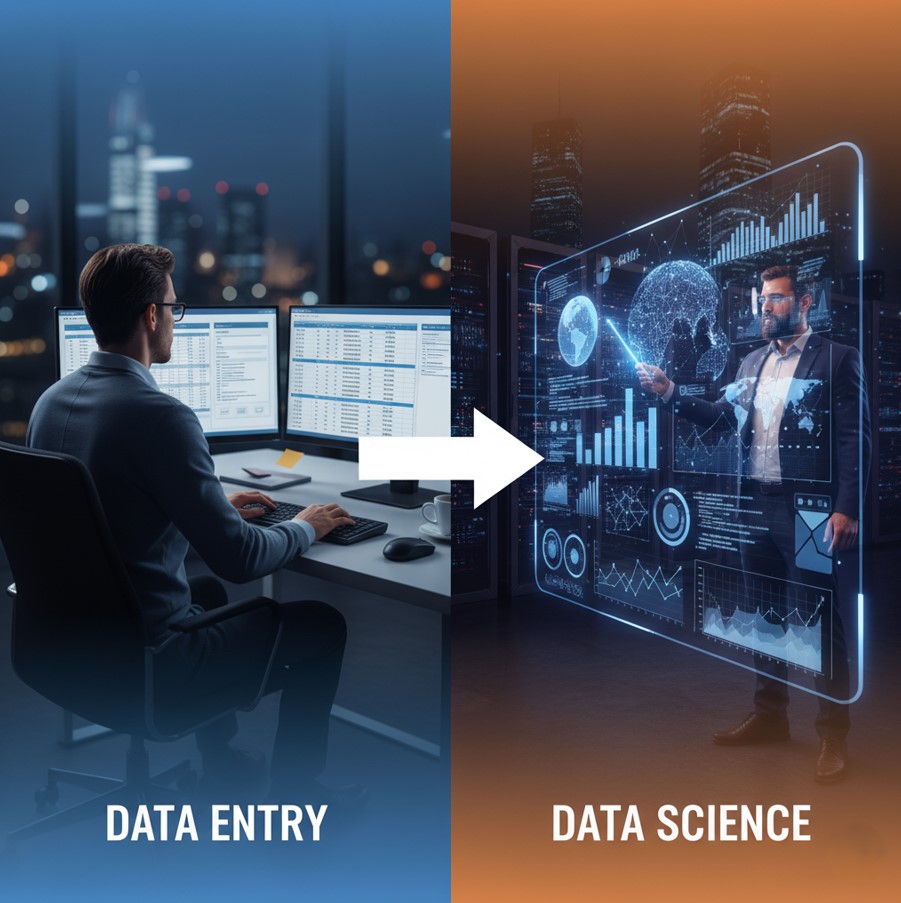
1. Skills
Data Entry:
- Typing speed and accuracy.
- Familiarity with tools like Excel, Google Sheets, or basic database software.
- Attention to detail for identifying errors in data.
Data Science:
- A solid foundation in programming languages such as Python, R, or SQL.
- Advanced statistical methods and machine learning techniques.
- Data visualization and storytelling skills using tools like Tableau or Matplotlib.
2. Tools
Data Entry:
- Microsoft Office Suite (Excel, Word).
- Simple data-entry apps and systems like Google Forms or CRM platforms like Salesforce.
Data Science:
- Programming environments like Jupyter Notebook or RStudio.
- Big data platforms such as Apache Spark.
- Machine learning libraries like TensorFlow and Scikit-learn.
3. Objectives
Data Entry:
- Maintaining accurate, organized data for operational use.
- Ensuring data availability for other business functions.
Data Science:
- Analyzing data to uncover meaningful insights.
- Helping organizations make informed decisions.
Overlap Between Data Entry and Data Science
Data entry, albeit with a broader perspective, lays the foundation for data science. Data scientists use this kind of data to analyze trends or build models.
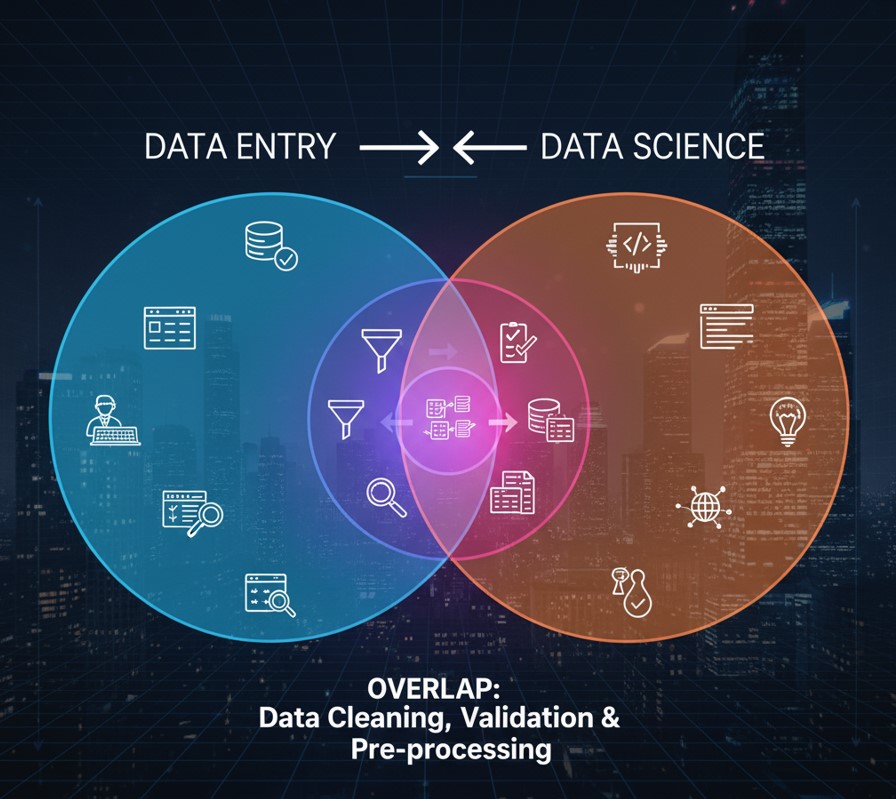
Examples of Overlap:
- Data Cleaning: Data scientists spend significant time cleaning messy datasets, a task similar to validating data during the entry process.
- Data Accessibility: Data entry professionals often prepare and organize data for use, making it accessible for data science projects.
- Smaller-scale Reporting: At times, data entry professionals may generate reports that contribute to large-scale data analysis.
Transitioning From Data Entry to Data Science
If you are working in data entry and you wish to move into data science, you are not alone! An entry-level data entry position is often viewed as a way in to more technical data-centric roles , such as data analysis or data science, by many professionals.
Here’s a roadmap to guide your transition.
1. Assess Your Current Skills
Take stock of your existing data-related skills. Your experience with Excel, attention to detail, and understanding of data organization are valuable starting points.
2. Learn Key Data Science Tools
Begin learning essential data science tools to bridge the skills gap. Recommended resources include:
- Python/R /R for programming.
- SQL for database management.
- Power BI or Tableau for data visualization.
3. Master the Basics of Statistics and Math
Familiarize yourself with statistical concepts like regression, probability, and hypothesis testing. Resources like Khan Academy and Coursera can teach you the basics.
4. Earn Certifications or Take Courses
Boost your credibility with certifications or online courses. Platforms like Coursera, edX, and DataCamp offer excellent programs for data science beginners.
5. Work on Projects and Build a Portfolio
Practical experience matters most. Create personal projects to showcase your data science skills:
- Analyze publicly available datasets from sites like Kaggle.
- Document your process and share insights through blogs or GitHub repositories.
6. Network and Find Mentors
Join data science communities on LinkedIn, Reddit, or forums like Kaggle. Networking can open doors to mentorships, job opportunities, and resources for growth.
Essential Skills for Aspiring Data Scientists
To establish yourself as a successful data scientist, you’ll need to master the following skills:
- Programming Proficiency:
Be fluent in Python, R, and SQL, and understand basic data manipulation.
- Statistical Thinking:
Learn the core principles of statistical analysis and how to apply them in data interpretation.
- Data Visualization:
Convey complex data insights with clarity using tools like Tableau or Matplotlib.
- Machine Learning:
Familiarize yourself with supervised and unsupervised learning algorithms.
- Problem-Solving Mindset:
Approach problems methodically and iteratively, using data to guide solutions.
Data Entry as a Gateway to Data Science
Although data entry will not replace data science, it can be a useful introduction to the field for those who are ready to work to reskill. You can evolve your career into a more applied and qualitative field in data science if you slowly work on building your computer programming, analytical ability, and statistics skills.
Remember, every data scientist starts somewhere. Why not start here?


